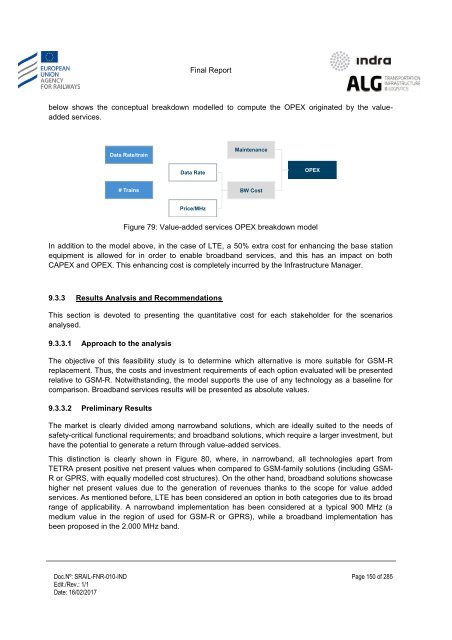Study on feasibility of SATCOM for railway communication
SRAIL-FNR-010-IND%20-%20FinalReport_v1.1_20170216
SRAIL-FNR-010-IND%20-%20FinalReport_v1.1_20170216
Create successful ePaper yourself
Turn your PDF publications into a flip-book with our unique Google optimized e-Paper software.
Final Report<br />
below shows the c<strong>on</strong>ceptual breakdown modelled to compute the OPEX originated by the valueadded<br />
services.<br />
Data Rate/train<br />
Maintenance<br />
Data Rate<br />
OPEX<br />
# Trains<br />
BW Cost<br />
Price/MHz<br />
Figure 79: Value-added services OPEX breakdown model<br />
In additi<strong>on</strong> to the model above, in the case <strong>of</strong> LTE, a 50% extra cost <strong>for</strong> enhancing the base stati<strong>on</strong><br />
equipment is allowed <strong>for</strong> in order to enable broadband services, and this has an impact <strong>on</strong> both<br />
CAPEX and OPEX. This enhancing cost is completely incurred by the Infrastructure Manager.<br />
9.3.3 Results Analysis and Recommendati<strong>on</strong>s<br />
This secti<strong>on</strong> is devoted to presenting the quantitative cost <strong>for</strong> each stakeholder <strong>for</strong> the scenarios<br />
analysed.<br />
9.3.3.1 Approach to the analysis<br />
The objective <strong>of</strong> this <strong>feasibility</strong> study is to determine which alternative is more suitable <strong>for</strong> GSM-R<br />
replacement. Thus, the costs and investment requirements <strong>of</strong> each opti<strong>on</strong> evaluated will be presented<br />
relative to GSM-R. Notwithstanding, the model supports the use <strong>of</strong> any technology as a baseline <strong>for</strong><br />
comparis<strong>on</strong>. Broadband services results will be presented as absolute values.<br />
9.3.3.2 Preliminary Results<br />
The market is clearly divided am<strong>on</strong>g narrowband soluti<strong>on</strong>s, which are ideally suited to the needs <strong>of</strong><br />
safety-critical functi<strong>on</strong>al requirements; and broadband soluti<strong>on</strong>s, which require a larger investment, but<br />
have the potential to generate a return through value-added services.<br />
This distincti<strong>on</strong> is clearly shown in Figure 80, where, in narrowband, all technologies apart from<br />
TETRA present positive net present values when compared to GSM-family soluti<strong>on</strong>s (including GSM-<br />
R or GPRS, with equally modelled cost structures). On the other hand, broadband soluti<strong>on</strong>s showcase<br />
higher net present values due to the generati<strong>on</strong> <strong>of</strong> revenues thanks to the scope <strong>for</strong> value added<br />
services. As menti<strong>on</strong>ed be<strong>for</strong>e, LTE has been c<strong>on</strong>sidered an opti<strong>on</strong> in both categories due to its broad<br />
range <strong>of</strong> applicability. A narrowband implementati<strong>on</strong> has been c<strong>on</strong>sidered at a typical 900 MHz (a<br />
medium value in the regi<strong>on</strong> <strong>of</strong> used <strong>for</strong> GSM-R or GPRS), while a broadband implementati<strong>on</strong> has<br />
been proposed in the 2.000 MHz band.<br />
Doc.Nº: SRAIL-FNR-010-IND<br />
Edit./Rev.: 1/1<br />
Date: 16/02/2017<br />
Page 150 <strong>of</strong> 285


